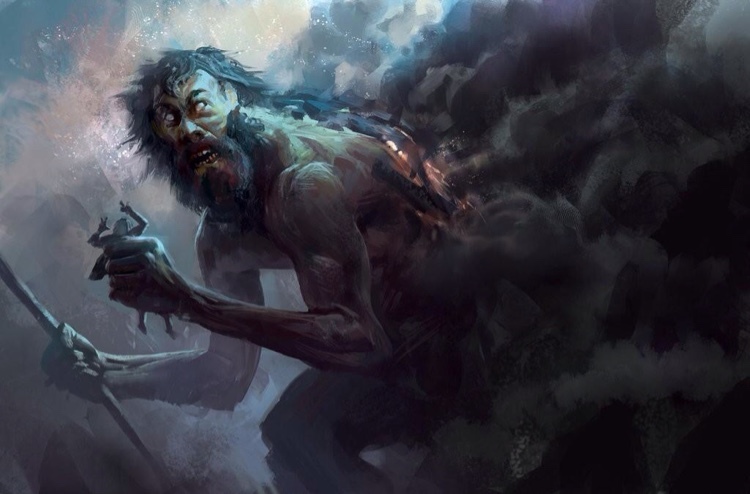Indian Holy MEN
Kapalika
The Kāpālika tradition was a non-Puranic, tantric form of Shaivism in India, whose members wrote the Bhairava Tantras, including the subdivision called the Kaula Tantras. These groups are generally known as Kāpālikas, the "skull-men," so called because, like the Lākula Pāsupata, they carried a skull-topped staff (khatvanga) and begging bowl.
They are one among the most feared among the holy men in India. They are great followers of Lord Rudra in his Kapalishwara form. In this form he wears ash from burned dead bodies all over his body and also wears a garland made of skulls and mediate in the cremation grounds.
Kalamukha
Scholars have commonly been associated the Kalamukhas with the Kāpālikas, or skull-bearers, another group of ascetics who undertook ascetic practices common to both Buddhist and Hindu Tantra. Like the Kapalikas, the Kalamukhas are often described as employing disturbing imagery of death and even cannibalism in their rituals. More recent scholarship on the Kalamukhas suggests they may not have had as much in common with the Kapalikas as has typically been thought; while the Kapalikas embraced horrific imagery, the Kalamukhas seem to have been a less extreme, favouring instead a temple-based approach.
A tribe named Kalamukha also finds description in Mahabharata during Sahadeva's conquest in Saurashtra. The text describes the tribe as a cross between human beings andRakshasas.
Aghori
Although akin to the Kapalika ascetics of medieval Kashmir, as well as the Kalamukhas, with whom there may be a historical connection, the Aghoris trace their origin to Kina Ram, an ascetic who is said to have lived 150 years, dying during the second half of the 18th century. Now a days both Kalamukhas and Kapalikas are seen under the title Aghori. They are said to posses great healing powers.
The Aghori ascetic is himself a symbol of the God Rudra in Shiva's form as Bhairava. The main symbol which makes him distinct from other sadhus is the skull cup he uses as a begging bowl. He goes naked or wears the shroud of a corpse, covers himself in the ashes of the cremation ground and always has his hair in matted dreadlocks.
If an aghori uses a corpse as part of his ritual worship, the corpse upon which he meditates, it is a symbol of his own body, and the corpse-devouring ritual is a symbol of the transcendence of his lower self and a realization of the greater, all pervading Self that is universal consciousness. They consider themselves as images or reflections of Rudra himself.
Nagas – The Warrior sadhus
Naga Sadhus are a particular group of Shaivite saints who reside in the Himalayan Caves and come to visit the civilization only during the Kumbh Mela. This is the only event when these ascetic saints can be seen among the general Indian population.
 |
| Lord Rudra , A drawing by Nalanda |
The Naga Sadhus have unique characteristic features drawing inspiration from Lord Rudra. They hold tridents crowned with human skulls. Their bodies are smeared in thick ash and they wear heavy coils of matted hair on the head. These saints remain completely naked even during biting cold.
They smoke Marijuana through a pipe called a Chillum or Shiv Muli. They use it as a tool to avoid the worldly distraction yet have self-control even in the intoxicated state. But as they advance in spiritual life they renounce intoxication too. The Naga Sadhus renounce the materialistic world and practice celibacy to escape from the cycle of birth and death and to attend salvation. As they belong to the Shaivite sect, they have matted locks of hair and their bodies are covered in ash like Lord Rudra.
They smoke Marijuana through a pipe called a Chillum or Shiv Muli. They use it as a tool to avoid the worldly distraction yet have self-control even in the intoxicated state. But as they advance in spiritual life they renounce intoxication too. The Naga Sadhus renounce the materialistic world and practice celibacy to escape from the cycle of birth and death and to attend salvation. As they belong to the Shaivite sect, they have matted locks of hair and their bodies are covered in ash like Lord Rudra.
Kumbh Mela is a mass Hindu pilgrimage of faith in which Hindus gather to bathe in a sacred river. It is considered to be the largest peaceful gathering in the world where around 100 million people were expected to visit during the Maha Kumbh Mela in 2013 in Allahabad.
It is held every third year at one of the four places by rotation: Haridwar, Allahabad (Prayaga), Nashik and Ujjain.
Thus the Kumbh Mela is held at each of these four places every twelfth year. Ardha ("Half") Kumbh Mela is held at only two places, Haridwar and Allahabad, every sixth year. The rivers at these five places are:
the Ganges (Ganga) at Haridwar, the confluence (Sangam) of the Ganges and the Yamuna and the mythical Saraswati at Allahabad, the Godawari at Nashik, the Shipra at Ujjain and the kausiki at Chataradham.









_Sadhu_in_Varanasi%2C_India.jpg)




Comments
Post a Comment